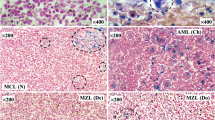Abstract
Isothermal remanent magnetization (IRM) acquisition and alternating field (A.F.) demagnetization analyses were performed on human heart, spleen and liver samples resected from cadavers. The magnetic properties of the samples were measured both at 77K and at 273K. A.F. demagnetization was performed at 273K. Results from the analyses of the tissue indicate the presence of ferromagnetic, fine-grained, magnetically interacting particles which, due primarily to magnetic properties, are thought to be magnetite and/or maghemite. The presence of superparamagnetic particles can be inferred from the increase in saturation IRM values when measured at 77K compared with measurements at 273K and the decay of remanent magnetization upon warming from 77K. The concentration of magnetic material (assuming it is magnetite or maghemite) in the samples varies from 13.7 ng g-1 to 343 ng g-1, with the heart tissue generally having the highest concentration. The presence of magnetic material in these organs may have implications for the function of biogenic magnetite in the human body.
Similar content being viewed by others
References
Cohen D. 1973 Ferromagnetic contamination in the lungs and other organs of the human body. Science 180, 745–748.
Dobson J, Grassi PP. 1996Magnetic properties of human hippocampal tissue: evaluation of artefact and contamination sources. Brain Res Bull 39, 255–259.
Dobson J, St. Pierre TG. 1996 Application of the ferromagnetic transduction model to D.C. and pulsed magnetic fields: Effects on epileptogenic tissue & implications for cellular phone safety. Biochem Biophys Res Commun 227, 718–723.
Dobson J, Fuller M, Moser S, et al. 1995 Evocation of epileptiform activity by weak DC magnetic fields and magnetite biomineralization in the human brain. In: Baumgartner C, Deecke L, Stroink G, Williamson SJ, eds. Biomagnetism: Fundamental Research and Clinical Applications. Amsterdam: Elsevier/ISO Press; 16–19.
Dunn JR, Fuller M, Zoeger J, et al. 1995 Magnetic material in the human hippocampus. Brain Res Bull 36, 149–153.
Kirschvink JL. 1992 Comments on "Constraints on biological effects of weak extremely-low-frequency electromagnetic fields". Phys Rev A 46, 2178–2184.
Kirschvink JL. 1996 Microwave absorption by magnetite: A possible mechanism for coupling non-thermal levels of radiation to biological systems. Bioelectromag 17, 187–194.
Kirschvink JL, Jones DS, MacFadden BJ, eds. 1985Magnetite Biomineralization and Magnetoreception in Organisms: a New Biomagnetism. New York: R.P. Plenum Publishing Corp.
Kirschvink JL, Kobayashi-Kirschvink A, Woodford BJ. 1992 Magnetite biomineralization in the human brain. Proc Acad Sci USA 89, 7683–7687.
Kobayashi A, Kirschvink JL. 1995 Magnetoreception and electromagnetic field effects: Sensory perception of the geomagnetic field in animals and humans. In: Blank M, ed. ACS Advances in Chemistry Series No. 250, Electromagnetic fields: Biological interactions and mechanisms. American Chemical Society; 367–394.
Merrill RT, McElhinney MW. 1983. The Earth's Magnetic Field: It's History, Origin and Planetary Perspective. London: Academic Press, Inc.; 401 pp.
Moskowitz BM, Frankel RB, Bazylinski DA. 1990 Rockmagnetic criteria for the detection of biogenic magnetite. Earth Planet Sci Lett 120, 283–300.
Ptitsyna NG, et al. 1996 Coronary heart diseases: assessment of risk associated with work exposure to ultralow-frequency magnetic fields. Bioelectromag 17(6), 436–444.
St Pierre TG, Webb J, Mann S. 1989 Ferritin and hemosiderin: structural and magnetic studies of the iron core. In: Mann S, Webb J, Williams RJP, eds. Biomineralization: Chemical and Biochemical Perspectives. Weinheim: VCH Verlangsgesellschaft; 295–344.
Webb J, St. Pierre TG, Macey DJ, 1990 Iron biomineralization in invertebrates. In: Frankel RB, Blakemore R, eds. Iron Biominerals. New York: R.P. Plenum Publishing Corp; 193–220.




